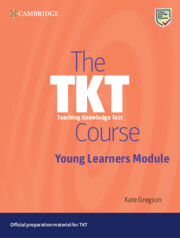Book contents
- Frontmatter
- Acknowledgements
- Contents
- Introduction
- Part 1 Knowledge of young learners and principles of teaching English to young learners
- Part 2 Planning and preparing young learner lessons
- Part 3 Teaching young learners
- Part 4 Assessing young learner learning in the classroom
- Follow-up activities: Answer keys and commentaries
- List of terms found in the TKT Glossary
- Glossary of TKT: Young Learners terms
- Test tips for TKT: Young Learners
- Teaching knowledge test young learners: Practice test
- Sample test answer sheet for TKT: YL practice test
- Answer key for TKT: YL practice test
Unit 11 - Why assess learning: What purposes do different types of classroom-based assessment have?
Published online by Cambridge University Press: 14 March 2024
- Frontmatter
- Acknowledgements
- Contents
- Introduction
- Part 1 Knowledge of young learners and principles of teaching English to young learners
- Part 2 Planning and preparing young learner lessons
- Part 3 Teaching young learners
- Part 4 Assessing young learner learning in the classroom
- Follow-up activities: Answer keys and commentaries
- List of terms found in the TKT Glossary
- Glossary of TKT: Young Learners terms
- Test tips for TKT: Young Learners
- Teaching knowledge test young learners: Practice test
- Sample test answer sheet for TKT: YL practice test
- Answer key for TKT: YL practice test
Summary
LEARNING OUTCOMES
By the end of this unit, you will…
KNOWLEDGE: know more about different purposes for various types of classroombased assessment
SKILLS: be able to identify why teachers use particular classroom-based assessment techniques
■ Starter Question
Before you begin this unit, read the starter question and make some notes. Then read the commentary and compare it to your notes.
What does the term ‘assessment’ mean to you?
COMMENTARY
Assessment is a key part of teaching and learning; it can be defined as: ‘to discover, judge, or form an opinion on learners’ ability, achievement, proficiency or progress either formally or informally’ (TKT Glossary, p. 4).
There are several different kinds of assessment including formal assessment, such as testing, where we assess children individually on their skills and knowledge, and informal assessment, which is carried out without the teacher setting a test: teachers continually assess informally during regular classroom activities, as a part of their everyday classroom practice. This is also known as classroom-based assessment. It may involve the use of classroom activities the teacher uses specifically to assess children, so they are planned as assessed activities which the teacher may observe or collect students’ worksheets from, or it may be through the use of strategies such as monitoring, observing, concept checking, eliciting and other kinds of questioning, which the teacher uses all the time to gain a sense of children's language and skills use. The teacher may plan these strategies in advance of the lesson, for example by scripting some questions to check understanding. We can see, therefore, that assessment can be anywhere from very formal to very informal, unplanned and unstructured.
Assessment may be done at the end of a period of learning, such as a term, course or even unit, in order to fi nd out what was achieved, and not achieved. This is known as summative assessment; it is often formal. This is a fi nal assessment of learning, so it does not infl uence future teaching and learning.
On the other hand, when assessment gives us information to help improve future teaching and learning, it is formative assessment. This is assessment for learning because we can use the assessment to improve teaching as well as learning. This kind of assessment usually happens in the classroom, so it is informal.
- Type
- Chapter
- Information
- The TKT Course Young Learners Module , pp. 118 - 125Publisher: Cambridge University PressPrint publication year: 2024

